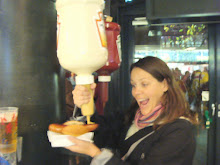 It started about a week ago. Everywhere I went I noticed white asparagus for sale. Apparently it’s Spargelzeit in Germany, which literally translates to "asparagus time." The fact that this produce is revered enough to be bestowed with an entire season should give you an idea about how German’s feel about the vegetable.
It started about a week ago. Everywhere I went I noticed white asparagus for sale. Apparently it’s Spargelzeit in Germany, which literally translates to "asparagus time." The fact that this produce is revered enough to be bestowed with an entire season should give you an idea about how German’s feel about the vegetable.White asparagus comes from the same plants that produce green asparagus, but the stalks are carefully covered with dirt as they grow, thus stopping the production of chlorophyll. To protect the valuable crop, fields are often covered with plastic, which makes for a strange-looking landscape.
Because of the labor required to keep the stalks white, the albino version of the vegetable demands a premium price. I've seem it going for as much as €12 per kilo, which at an exchange rate of 1.59 is close to $10 per pound. But devotees claim that the white variety is milder than the green version, though it also reputed to be more bitter.
On Saturday, after driving home from an ill-fated trip to Linz in search of Linzer Tarts,* Kevin and I spotted a farm stand selling nothing but white asparagus. We stopped, picked up a bundle, and decided to see for ourselves what all the fuss is about. That night I steamed it and served it with lemon vinaigrette. It was quite tasty and a nice accompaniment for red snapper and leek stuffing baked in parchment.
* Linzer Tarts come from Linz, Austria, not Linz am Rhine, Germany. I discovered this point of fact just before heading out the door, but decided to ignore it. I figured that if I owned a bakery in Linz, I’d certainly sell the cookies. The shop owners didn't agree with my irony and I came home empty handed.




























